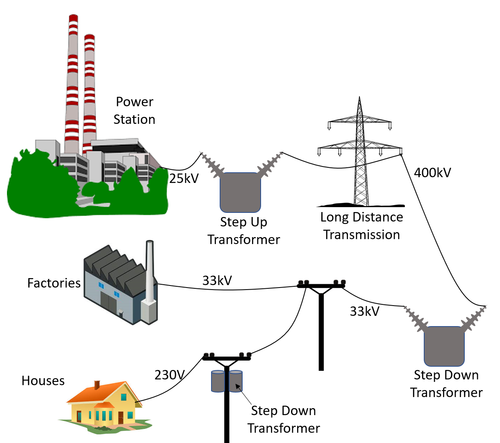Difference between revisions of "National Grid"
| Line 1: | Line 1: | ||
==Key Stage 4== | ==Key Stage 4== | ||
===Meaning=== | ===Meaning=== | ||
| − | The '''national grid''' is a network of [[Power Station|power stations]], | + | The '''national grid''' is a network of [[Power Station|power stations]], transmission lines and [[Electrical Transformer|transformers]] which generate and transmit [[electricity]] across the United Kingdom. |
===About The National Grid=== | ===About The National Grid=== | ||
: The National Grid consists of several stages: | : The National Grid consists of several stages: | ||
#[[Power Station]]s - [[Electricity]] is generated with a [[Potential Difference|potential difference]] of around 25kV. | #[[Power Station]]s - [[Electricity]] is generated with a [[Potential Difference|potential difference]] of around 25kV. | ||
| − | #[[Electrical Transformer#Step Up|Step Up Transformer]] - The [[Potential Difference|potential difference]] of the [[electricity]] is increased to around 400kV for long distance transmission. This is because the higher [[Potential Difference|potential difference]] means a lower [[Electrical Current|current]] so less [[energy]] will be dissipated through heating the | + | #[[Electrical Transformer#Step Up|Step Up Transformer]] - The [[Potential Difference|potential difference]] of the [[electricity]] is increased to around 400kV for long distance transmission. This is because the higher [[Potential Difference|potential difference]] means a lower [[Electrical Current|current]] so less [[energy]] will be dissipated through heating the transmission lines. |
| − | #Long Distance | + | #Long Distance Transmission Lines - [[Electricity]] is transmitted at very high [[Potential Difference|potential difference]] (400kV) so it is kept on very high transmission lines. |
#[[Electrical Transformer#Step Down|Step Down Transformer]] - The [[Potential Difference|potential difference]] of the [[electricity]] is lowered to be sent to factories and neighbourhoods at 33kV. | #[[Electrical Transformer#Step Down|Step Down Transformer]] - The [[Potential Difference|potential difference]] of the [[electricity]] is lowered to be sent to factories and neighbourhoods at 33kV. | ||
| − | #Short Distance | + | #Short Distance Transmission Lines - [[Electricity]] is transmitted at 33kV over a short distance. |
#Neighbourhood [[Electrical Transformer#Step Down|Step Down Transformer]] - The [[Potential Difference|potential difference]] is lowered to 230V for use in houses. | #Neighbourhood [[Electrical Transformer#Step Down|Step Down Transformer]] - The [[Potential Difference|potential difference]] is lowered to 230V for use in houses. | ||
Revision as of 21:05, 7 April 2019
Key Stage 4
Meaning
The national grid is a network of power stations, transmission lines and transformers which generate and transmit electricity across the United Kingdom.
About The National Grid
- The National Grid consists of several stages:
- Power Stations - Electricity is generated with a potential difference of around 25kV.
- Step Up Transformer - The potential difference of the electricity is increased to around 400kV for long distance transmission. This is because the higher potential difference means a lower current so less energy will be dissipated through heating the transmission lines.
- Long Distance Transmission Lines - Electricity is transmitted at very high potential difference (400kV) so it is kept on very high transmission lines.
- Step Down Transformer - The potential difference of the electricity is lowered to be sent to factories and neighbourhoods at 33kV.
- Short Distance Transmission Lines - Electricity is transmitted at 33kV over a short distance.
- Neighbourhood Step Down Transformer - The potential difference is lowered to 230V for use in houses.
| A diagram of the national grid. |
